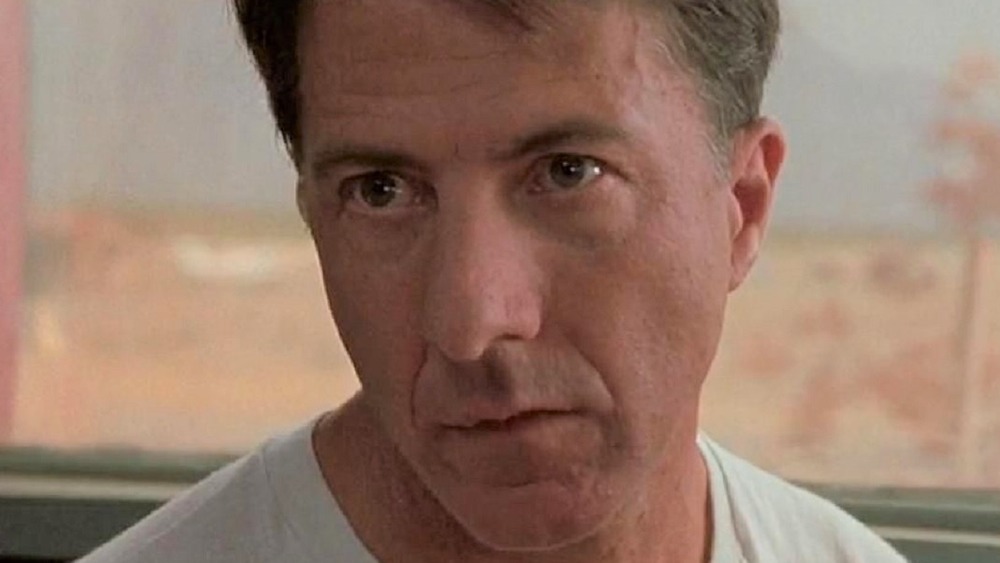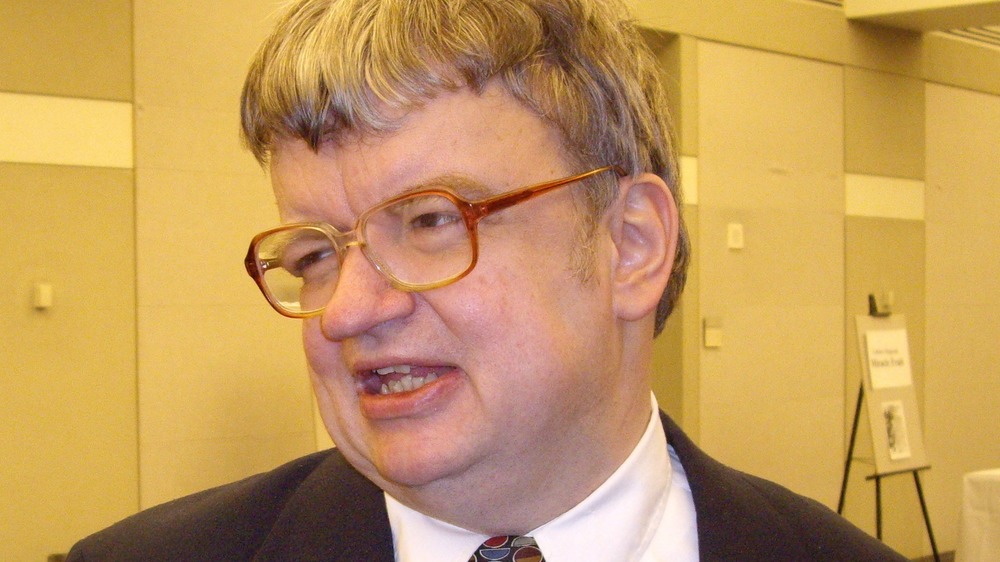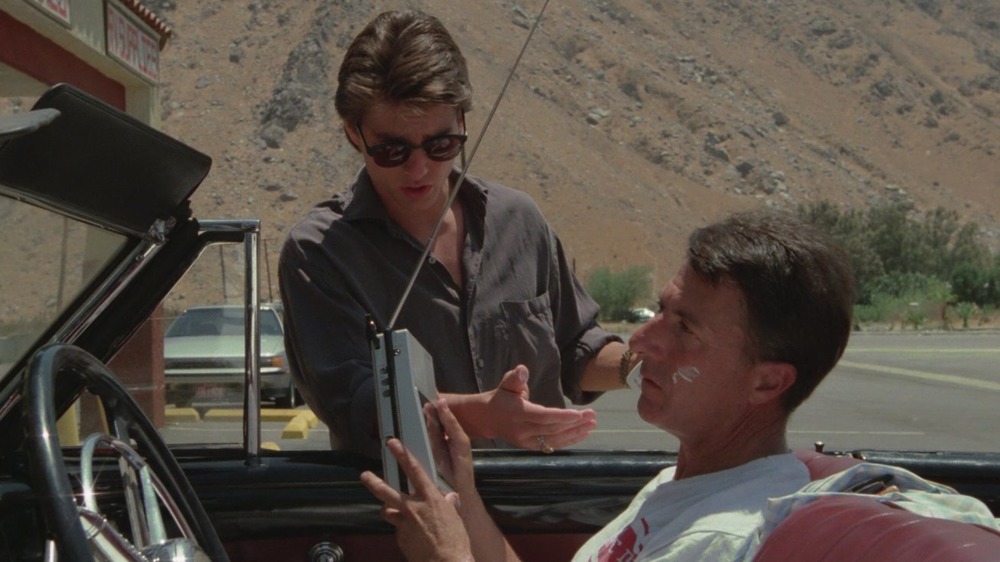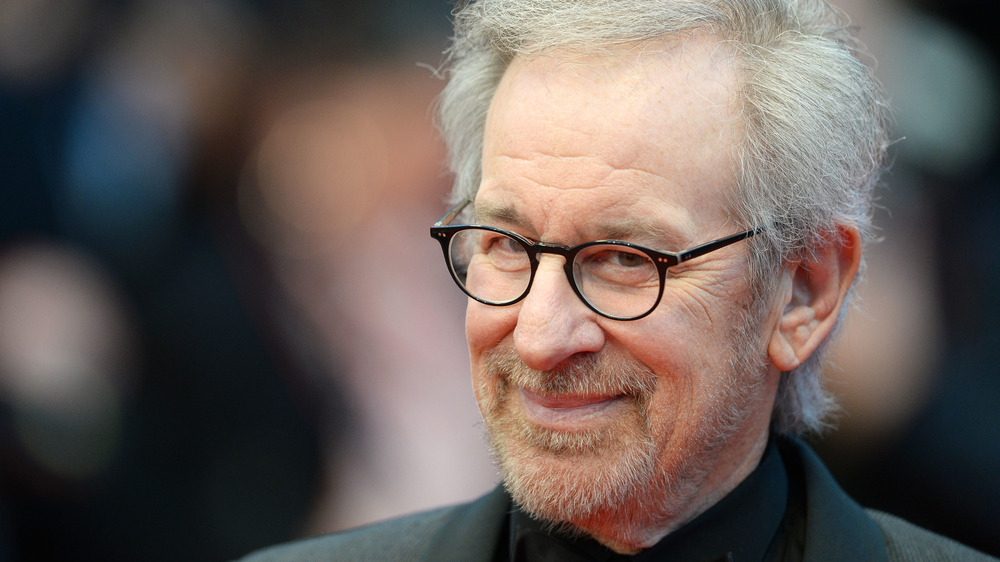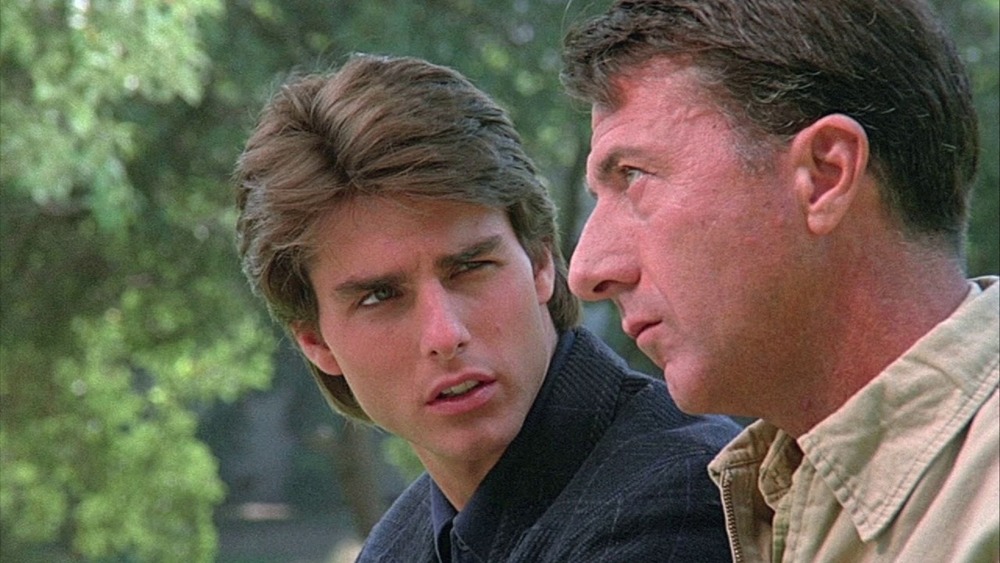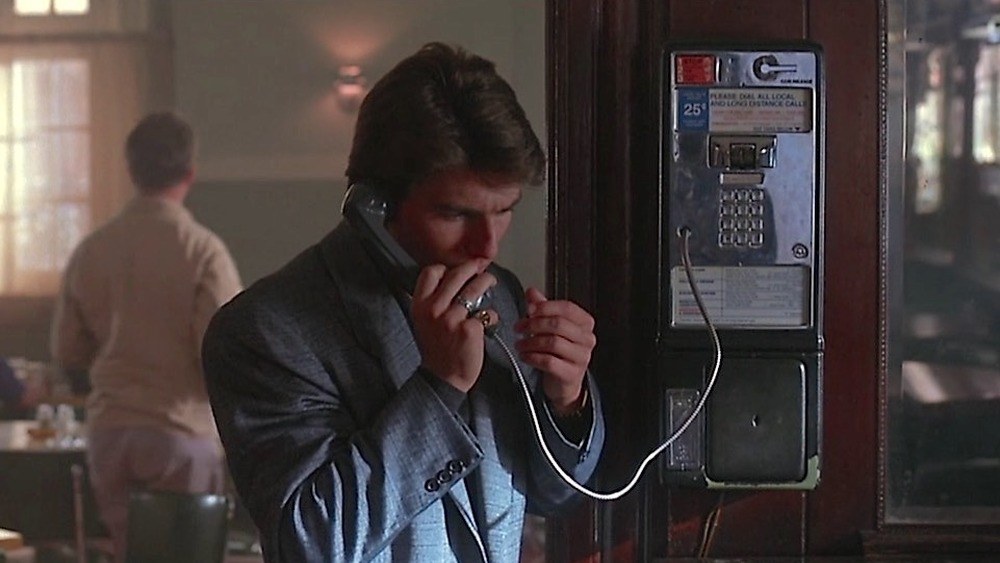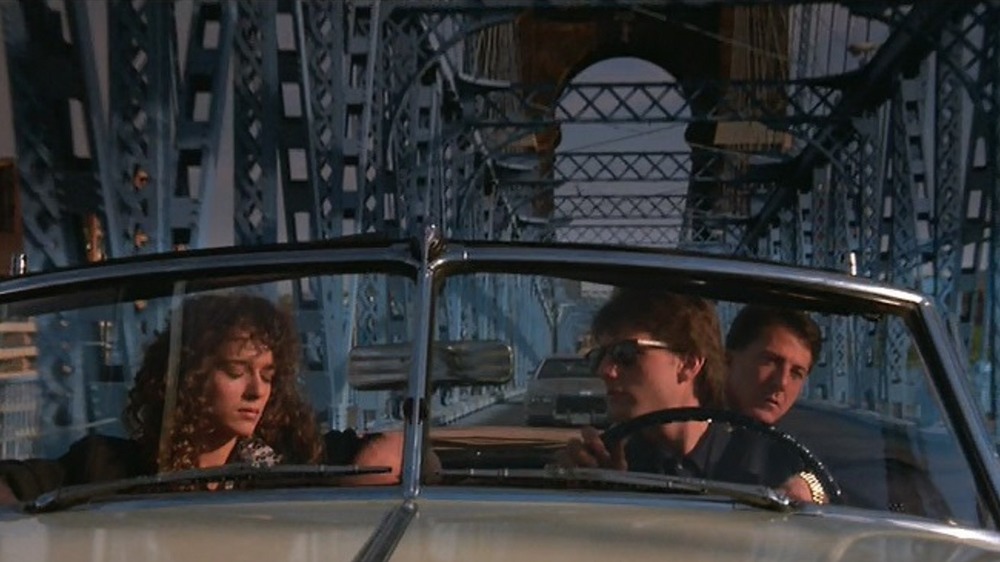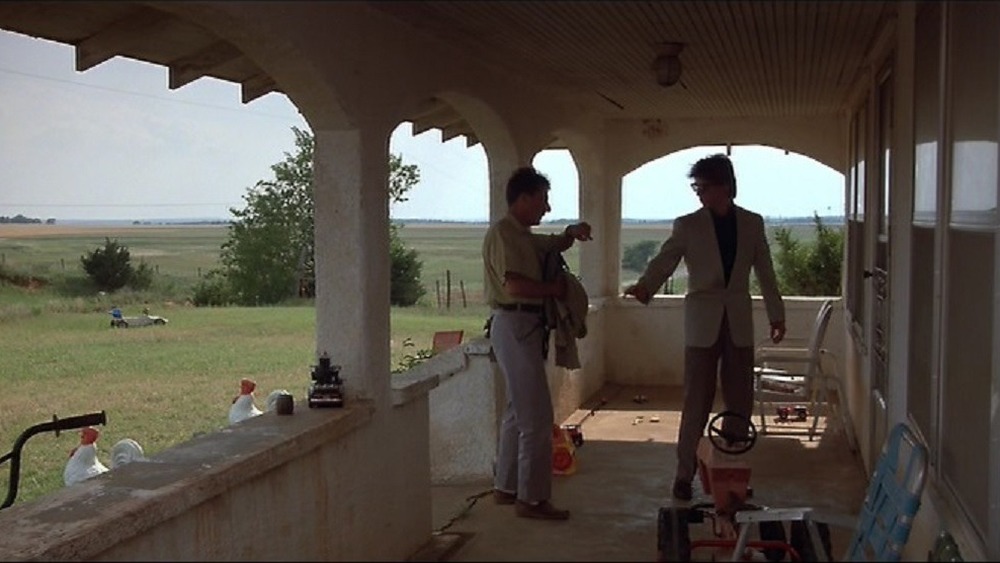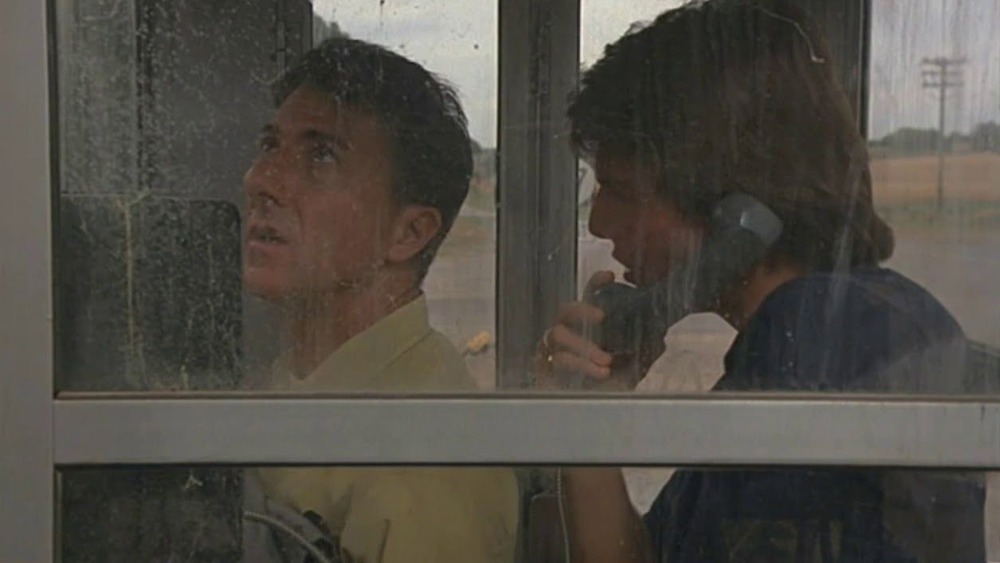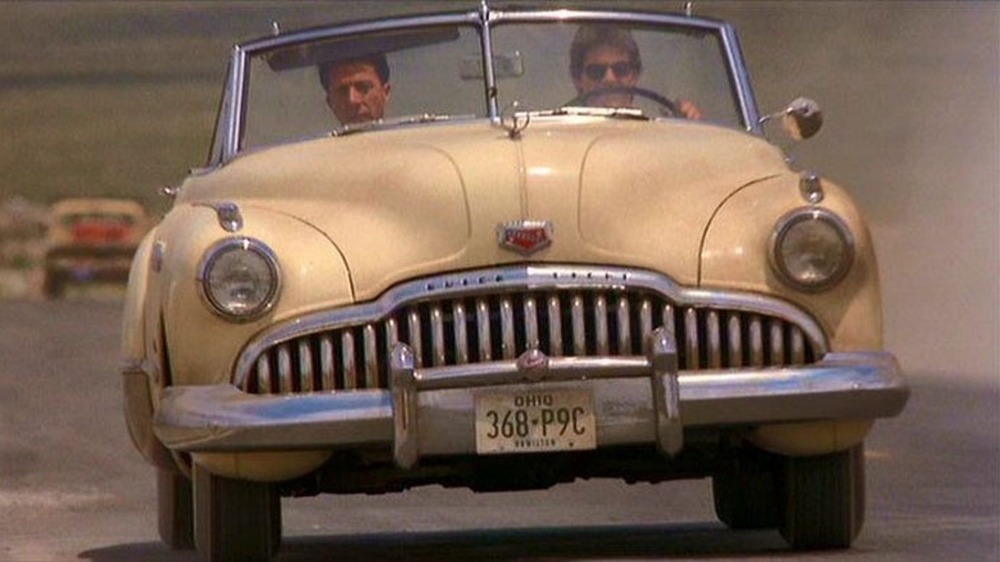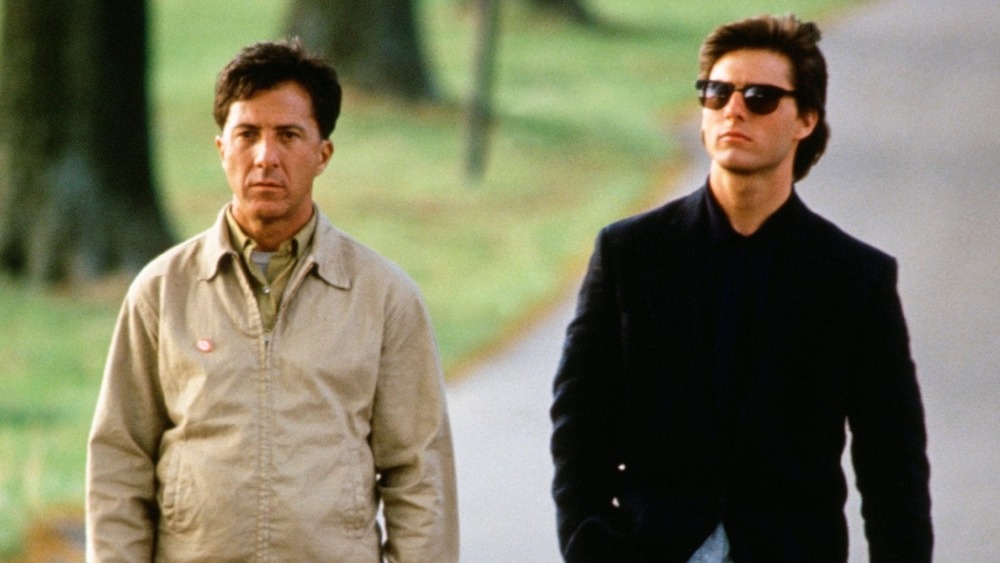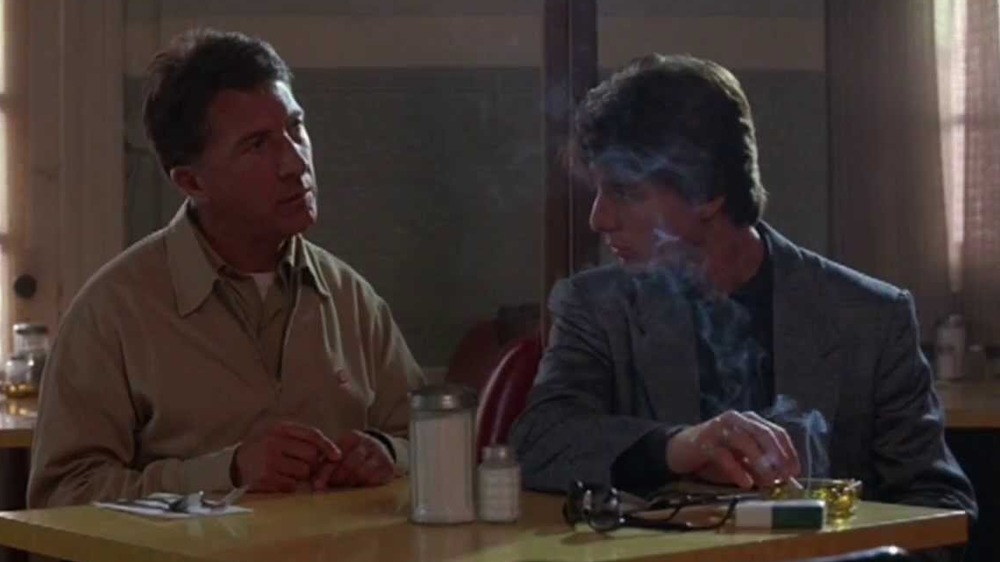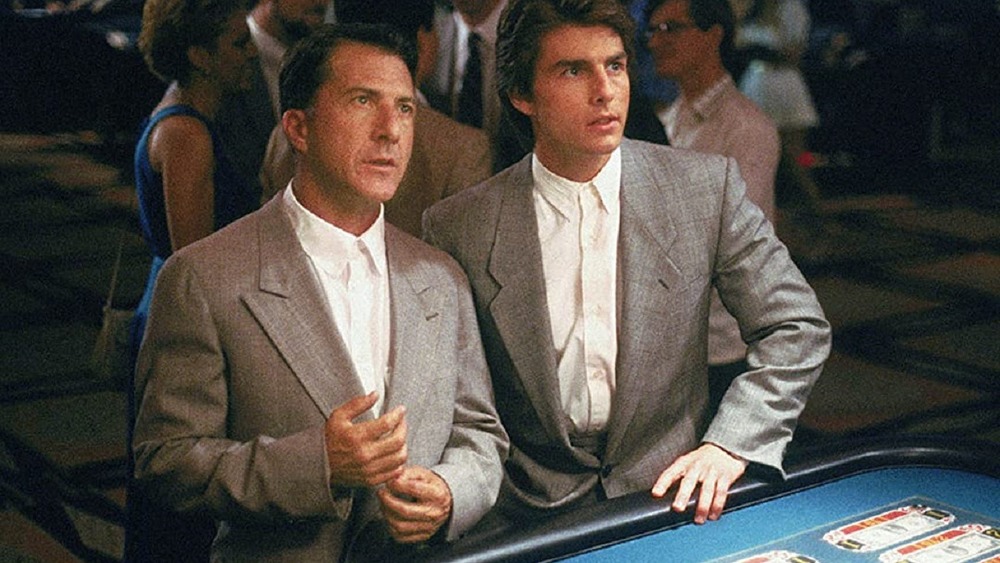The Untold Truth Of Rain Man
In 1988, a movie with a confusingly weather-related title topped the box office, shone at the Academy Awards, and introduced a previously unaware public to a developmental disorder called autism — or rather, to one version of it.
Rain Man starts with scheming car salesman Charlie Babbitt (Tom Cruise) learning that he has an older brother with autism, Raymond (Dustin Hoffman), to whom their late father left most of his fortune. Charlie decides to become Ray's legal guardian as a cash grab, and he effectively kidnaps him from the institution he's been living in for decades. Driving back to LA from Ohio, Charlie realizes that Ray is both more brilliant and more developmentally challenged than he realized. His impatience runs straight into Ray's reliance on routine as a source of stability, and Charlie is eventually forced to think about the needs and demands of someone other than himself.
The movie was so successful that the title has become a byword for someone who struggles socially but has genius-level mathematical and memory abilities. But the untold truth of Rain Man is that what you see on the screen is nowhere near the full story.
Rain Man drew on multiple real people for inspiration
Believe it or not, the script for Rain Man – and especially the character Ray — was inspired by multiple real people.
The plot point that sees Charlie kidnap Ray from the institution and petition to become his guardian was taken from something original screenwriter Barry Morrow actually did. Without the avaricious motivation. Morrow became the legal guardian of his friend, Bill Sackter, to prevent him from being sent back to the institution he'd lived in for most of his life. Before Rain Man, Morrow told this story in the TV movie Bill, starring Mickey Rooney as Sackter.
Morrow also partly based Ray on Kim Peek, a man he'd met in 1984 who was a mega-savant with skills similar to Ray, as well as similar disabilities. Unlike Ray, Peek — who died in 2009, aged 58 — was not autistic. However, he did have an incredible memory. By the time he died, Peek had memorized around 12,000 books. He could read two different pages at the same time, with one eye on each page. He could also remember the day of any date, as well as any zip code, map or travel route across the US. Peek also had mental disabilities that affected his physical coordination, and he needed help to get dressed and brush his hair and teeth. Plus, he couldn't understand metaphors or do basic reasoning.
When Morrow won the Oscar for Best Original Screenplay for Rain Man, he gave Peek the statuette. Peek generously let people hold it at public appearances.
Rain Man went through multiple writers and directors
According to Rolling Stone, Rain Man went through three directors and six writers before finding the dream team of screenwriter Ronald Bass and director Barry Levinson.
Barry Morrow came up with the story, based on his relationships with Kim Peek and Bill Sackter, and he wrote the first script for MGM. The studio eventually handed it to Ronald Bass, who only had three minor screenwriting credits to his name but would later write The Joy Luck Club, Dangerous Minds, and My Best Friend's Wedding. As for Levinson, he was an established screenwriter by the time he came to Rain Man. He'd even been nominated for two writing Oscars — one for the Al Pacino-starring And Justice for All and another for Diner, which he'd also directed. He'd also just directed the Vietnam War comedy Good Morning, Vietnam.
Looking at the script, Levinson felt that there was too much action, which detracted from the heart of the story — the relationship between the brothers. One draft even had Ray building a motorcycle from scratch to escape a motorcycle gang. So Levinson and Bass worked together to create a draft that put the focus back on the Babbitts. As Levinson told Rolling Stone, "If I can make the relationship work with these two guys on the road, then that's enough for me." Unfortunately, a writers' strike meant the script wasn't finished by the time filming started. But Morrow and Bass still won the Best Original Screenplay Oscar for Rain Man, while Levinson picked up Best Director.
A lot of famous filmmakers turned down the project
While Rain Man was going through its drafting phase, multiple well-known actors and directors signed on and dropped out. Potential directors included Tootsie and Out of Africa director Sydney Pollack (who'd later direct Cruise in The Firm and act opposite him in Eyes Wide Shut) and Martin Brest, famous for Oscar-winner Scent of a Woman and infamous for writing and directing Gigli, a favorite of the Razzies.
The most famous director attached and then detached from Rain Man was Steven Spielberg. In a 1990 interview, Spielberg explained that he'd spent five months working on Rain Man with Cruise, Hoffman, and screenwriter Ronald Bass. But he had to leave the project to fulfill a promise to George Lucas that involved making Indiana Jones and the Last Crusade. Spielberg said that he regretted departing from Rain Man, especially when the awards started rolling in. "Maybe I should have forgotten my entire friendship with George Lucas," he laughed.
On the acting side, Mel Gibson turned down the part of Ray, and Mickey Rourke turned down Charlie. Rourke had also previously turned down another part that ultimately went to Cruise — Maverick in Top Gun. One interesting combination we never got to see involved Bill Murray playing Ray and Hoffman playing Charlie, but Murray declined the role.
Dustin Hoffman considered quitting
Dustin Hoffman threw himself into researching the role of Ray. He read books by autistic author Temple Grandin and non-autistic scientist Dr. Oliver Sacks, who wrote about a pair of twins, John and Michael, who both had autism and extraordinary mathematical abilities. The scene in Rain Man in which Ray is able to tell immediately how many matchsticks have spilled onto the floor is based on something the twins actually did.
Hoffman also studied a documentary about Joseph Sullivan, an autistic mathematical savant with an incredible memory, whose mother worked as a consultant on Rain Man. In fact, Sullivan met Hoffman on set. Hoffman also estimated that 90% of Ray's dialogue and many of his mannerisms came from an autistic man named Peter Guthrie. Peter's brother, Kevin, sent Hoffman tapes of their conversations.
Despite all his research, two weeks into filming, Hoffman felt that he wasn't doing Ray justice. "It was the worst work I had ever done," he told the AP. At one point, he suggested the production replace him with Richard Dreyfuss. But it was while filming the scene in which Ray talks about his underwear — from Kmart at 400 Oak Street in Cincinnati — that Hoffman had what he felt was an epiphany into his character. He explained to the AP, "I suddenly realized ... he is nowhere if he's not in the now. ... I know something about obsession, and I'm comfortable being obsessive. The rest of it just took care of itself."
Tom Cruise was seen as an odd casting choice
Tom Cruise was cast early on in Rain Man's long pre-production lifespan. But he was seen as an odd choice for a dramatic movie in which the emotional arc rested largely on his shoulders.
As Barry Levinson explained to The New York Times, Ray doesn't change because he's most comfortable with routine. Charlie is the one who goes on an emotional (as well as literal) journey, from self-centered wheeler-dealer to a caretaker who tries his best to understand Ray. Up until Rain Man, Cruise had been seen as a good-looking action or romantic lead. His three biggest movies had been Cocktail, in which he played a rebellious cocktail bar owner, Risky Business, where he played a rebellious teenager, and Top Gun, in which he played the Maverick. None of the roles had an abundance of emotional depth.
Cruise agreed Charlie was "a challenge," but that was the appeal. He told the AP, "It was different. ... It was the best role that I've had in my career to date." And his co-star was confident in him. Hoffman and Cruise improvised with each other, including playing each other's characters, and Hoffman said of Cruise to The New York Times, "We were linked into each other — which allowed us to be rough with each other. There's an emotionality between us that's very difficult to act — that permitted moments to happen between us."
Rain Man put a big city on the Hollywood map
When the Rain Man team was looking for somewhere to serve as Wallbrook (the institution where Charlie finds Ray), the producers got in touch with Cincinnati-based location scout Lori Holladay, who recommended Kentucky's St. Anne's Convent, a spot Holladay remembered from growing up in the area. In 1988, the convent was home to nuns belonging to the Congregation of Divine Providence, but in 2012, it was sold to the Diocese of Covington, which now rents it out as a retreat. The crew added a fake pond for a scene between Ray and Charlie that's shown in publicity stills but didn't make it to the film.
The film's funeral was also filmed in Kentucky, at Evergreen Cemetery. And the restaurant scene involving spilled toothpicks was filmed at Pompilio's restaurant in Newport, KY. As of 2019, the restaurant still had the table Hoffman and Cruise sat at. Then-owner Frank Mazzei told WCPO of the superstars, "They were very nice to work with. ... They particularly liked our lasagna."
The city of Cincinnati claimed a few pivotal locations, too. The Dixie Terminal served as a bank, and Ray, Charlie and Susanna (Valeria Golino) drove across the Roebling Bridge. Kristen Schlotman, executive director of Film Cincinnati, credits Rain Man with sparking interest in filming in the city, with the town's credits including The Killing of a Sacred Deer, The Ides of March, and Carol.
Oklahoma is very proud of Rain Man
As most of Rain Man is a road trip, the producers had to find somewhere that Ray and Charlie could travel through. According to Mary Nell Clark (via Tulsa World), then-executive director of the Oklahoma Film Office, Oklahoma earned the honor thanks to its "old gas pumps, breathtaking landscapes, the rustic look."
The scene in which Ray stands in the middle of an intersection blocking traffic was shot in Guthrie, OK. The man driving the pickup truck who shouts at Ray was local oil producer Jack Cope, whose wife had bought him a spot in the movie at a charity auction. Cope improvised his lines opposite Hoffman.
Another local who stole a scene was Byron Cavnar, who played the man in the psychiatrist's waiting room. Byron and his wife, Elmeta, were supposed to sit quietly. But Byron started chatting to Hoffman about the Pony Express, and Levinson silently turned the cameras on.
Other Oklahoma locations include the farmhouse where the brothers watch The People's Court with the Dougherty family, all of whom received credits. And the tiny gas station where Charlie and Ray stop to make a call from a phone booth — with gassy consequences — was filmed in Cogar, OK, which had never even had a movie theater. Even the motel that's supposed to be in Amarillo, Texas, was actually in Oklahoma. To this day, Rain Man holds a special place in Oklahoma's collective heart, as it's the only Best Picture Oscar-winner to have been shot in the state.
The phone booth fart scene was too real for Tom Cruise
Rain Man may be the only Best Picture winner to have a fart joke ... but Tom Cruise wasn't laughing.
When Ray and Charlie are crammed in a phone booth in remote Oklahoma, Ray lets one rip, accompanied by the phrase, "Uh oh, fart." Still on the phone, Charlie asks in disbelief, "Did you fart, Ray? ... How can you stand that?" He then tries to crack the door open. But as with many of the lines that made the final cut, that moment wasn't in the script. Cruise told The Graham Norton Show that Hoffman really farted in the tiny phone booth and that he was "grossed out" by his co-star. Cruise stayed in character enough to call Hoffman by his respective character's name, but he really was trying to open the door. "I tried to get out of the booth, and everything I said to him was real," Cruise added.
For his part, Hoffman has no regrets. He's said that the scene is one of his favorites from Rain Man, telling interviewer Rajeev Masand that Levinson encouraged them to improvise, so when Cruise went with the gaff (well, guff), Hoffman kept the scene going, too. "And it's one of the high moments of my life. I have done Shakespeare, and I have done plays by Arthur Miller, but nothing can touch the fart scene," he said.
The car was the star
Sure, Hoffman and Cruise were the ones with their names on the poster. But the third star of Rain Man was the Sequoia Cream 1949 Buick Roadmaster convertible that both drove (pun intended) Charlie and his father apart and brought him and Ray together. Not only did spending hours on the road force the two brothers to get to know each other, but it was their father's decision to leave Charlie the car and Ray everything else that pushed Charlie to seek his sibling out (and ultimately kidnap him for the inheritance).
However, the car was even rarer than Charlie claims. He tells Susanna that Buick only made 8,000 production models of the 1949 Roadmaster convertible, but according to auction site Hemmings, it was only 2,911. And two went on to star in Rain Man. One was used for the green screen shots, and the other was used for driving scenes.
In 2012, one of the two cars sold for $170,500 at auction. Levinson bought the other car after production wrapped. It later appeared on docuseries Chasing Classic Cars, and Levinson loaned it to host Wayne Carini for a fundraising effort in aid of an autism charity, as Carini's daughter Kimberly is autistic.
Rain Man wasn't expected to be a hit
This side of the 1989 Academy Awards, it's hard to imagine anyone thinking that Rain Man wouldn't be a hit. But before, during, and right after filming, that was anything but a certainty.
For starters, Rain Man had been in limbo for years when it was finally ready to shoot. And when Barry Levinson came on board, he had only eight weeks to prepare for filming, including turning the script around. Added to that particular pressure, there was a writers' strike on the horizon. Ronald Bass wrote as much as he could before it started, but the script wasn't finished when the company town's writers downed their tools. This also meant there couldn't be any rewrites during production.
On the bright side, no possibility of rewrites meant no studio executives lingering around and interfering. So Levinson and his cast and crew hit the road and made the rest up as they went. They also mostly shot chronologically, which allowed Levinson to add details and scenes that reflected the developing relationship between the characters.
As a result, the team working on the project was sold. Producer Mark Johnson said that crew members throughout were telling him that Rain Man was going to win Oscars. Still, Johnson wasn't convinced, even after he'd watched early cuts. "I'm just hoping it goes through the gate," he told Grantland of that tricky time.
Rain Man was adapted for the stage
Forget imitation. The sincerest form of flattery in the world of movies is a stage adaptation. And in 2008, Rain Man was given a theatrical reworking by playwright Dan Gordon, opening in London's West End that September.
Josh Hartnett of Pearl Harbor fame played Charlie, and British actor Adam Godley starred as Ray. Godley was an established stage actor, but his most recognizable screen roles to that point were as a teacher in Love Actually and Elliott Schwartz in Breaking Bad. More recently, he played a nefarious spiritual adviser in The Great, and he voices Pogo in The Umbrella Academy.
As for the play itself, it received mixed reviews, but it did well enough to earn a touring run with a new cast in summer 2018, which was extended into 2019.
Autism advocates have mixed feelings about Rain Man
One thing autism advocates tend to agree on is that before Rain Man, the vast majority of non-autistic people had no idea what autism was and didn't care. The movie addresses this by showing people's confusion when meeting Ray. Rain Man's success not only made moviegoers aware of autism, it also led to an increase in funding for medical research. Ray helped audiences put a face to a vague medical term in a way that often needs to happen for people to take an interest in something they have no personal experience with.
However, Rain Man's popularity became a double-edged sword. As Professor Katherine Loveland wrote on ABC, "It's very important to recognize that people with autism are not all alike. In fact, they can vary widely across a spectrum of disorder." Only approximately one in ten people with autism has savant-style skills like Ray, but the success of the movie means that many non-autistic people immediately assume that anyone they meet who's autistic must also be a genius. In addition, as The A.V. Club pointed out, Charlie only warms to Ray when he realizes he has these superior mathematical talents that he can use to his advantage. Rain Man helped raise awareness of a very narrow version of autism, but there are so many other stories to tell.
